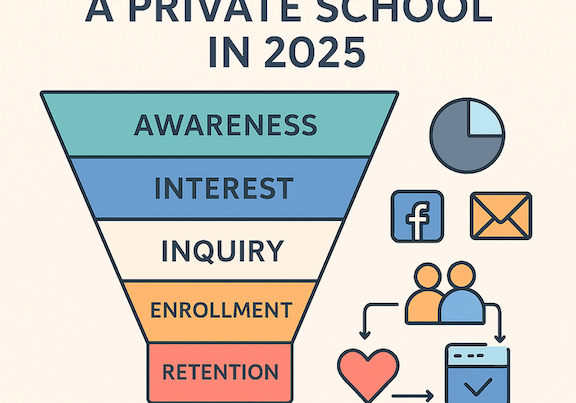According to IBISWorld, private schools have generated $92 billion in revenue thus far in 2021. Additionally, the market size growth of private schools is expected to continue growing at least 2.5% by the end of the year.
Considering this, the educational industry offers many opportunities to attract and retain students when implementing proper marketing strategies.
As a part of the school leadership, marketing, or admissions team, it’s understandable that different ways to convince students to attend the school are at the top of the team’s agenda.
Collecting and reviewing the analytics for schools can be incredibly helpful when utilized the right way; however, understanding where to start can become a challenging undertaking.
Keep reading to learn how to improve marketing for academic institutions using school analytics.
SEO (Including Content Marketing)
Search engine optimization, also referred to as SEO, is related to how website pages rank when consumers search online.
Several tools can be utilized to ensure everything on the school’s website, from the images to the content, is adequately optimized.
Google Analytics for SEO
Google Analytics provides schools with the tools needed to track the performance of SEO campaigns, such as the organic traffic the website attracts via search engine pages. The analytics give institutions a deeper understanding of how their SEO strategy is performing including challenges that need to be addressed.
Pinpointing the issue(s) associated with challenges is the first step to solving low website traffic and can be performed using the Channel Grouping report. After finding the channel grouping report, find your way to the acquisition page. Next, find the all traffic tab to view the channels page and click on Organic Search.
As a result, you’ll know how successful your SEO efforts are from the information you receive regarding top exit pages, which search engines you’re receiving an immense amount of traffic from, and which keywords work best for traffic.
Furthermore, the top landing pages in terms of search practices will become more apparent.
In addition to helping with SEO efforts, this will help with content marketing since it facilitates finding out which pieces of content have the most significant amount of success and which successful keywords to continue including as more content is created.
Google Analytics also creates a situation in which it is possible to measure:
- Quality of a website’s SEO traffic
- Assign a dollar value to a website’s organic traffic
- Identify any loading page times that are slow
Institutions can view their SEO data and analytics like the ones listed above on the SEO dashboard.
Consequently, these analytics will help private schools improve SEO and content marketing strategies to increase the number of students registered to attend the school.
SEMRush
SEMRush is a beneficial tool to help institutions understand how well the website is performing. Furthermore, in terms of SEO, they can find out how they’re doing by using SEMRush’s SEO Toolkit. The Toolkit can be used to identify which keywords are helping the website’s ranking.
The SEO Toolkit can also track:
- The visibility improvement of the website
- How a website page ranks for specific keywords
Moreover, it can be used to discover the monthly search volume of a keyword.
Furthermore, the school’s marketing team can analyze the backlinks that lead to the website from other websites, determine how the website compares against the competition, and discover keywords they can use for SEO strategy and content.
SEMRush also provides recommendations on how to optimize content to increase the amount of organic traffic.
Using the SEO tool, one can improve and master their various marketing strategies by implementing the right SEO techniques.
Social Media
Another important element involved in a school’s online presence strategy is social media. Posting regularly on relevant channels will help generate a larger following. Due to the increase in engagement, the school’s social media presence will grow stronger and increase trust among its audience.
Further, making the use of social media analytics one of the most potent tools a private school can utilize to help improve its marketing.
HubSpot
When schools utilize analytics provided by HubSpot, educational leaders can discover how their school’s social media performance affects the growth of the school and its revenue. They can look at every single one of their social media channels and find out how successful they are.
Hubspot makes it possible to study how social media channels perform in correlation to one another, which is helpful when a campaign is run across different channels. Hubspot tools provide data depicting the success of the campaign and the difference on each social platform.
Additionally, institutions receive visuals and graphs providing information about each social media platform’s impressions, session lengths, and audience.
Equipped with this information, educational leaders can discover which platforms are working efficiently and provide information about which strategies require modifications.
BuzzSumo
After writing a blog post or other informative pieces of content, it’s not uncommon to share it on the school’s social media platforms. How can success be measured doing this? BuzzSumo can help!
BuzzSumo is a tool that facilitates an environment making it possible to understand how much social engagement each social media account attracts when content is shared.
Furthermore, several BuzzSumo features make it easy to understand:
- Your competitive advantage to know how you compare to the competition
- How content performs in terms of keyword usage
- Total number of shares on platforms such as Pinterest, Twitter, and Facebook
Consequently, having access to this data, social media efforts can be modified to ensure published content will receive the maximum amount of engagement and attention when shared on social media platforms.
SproutSocial
SproutSocial is another helpful tool that provides more in-depth information about social media strategy performance. Academic institutions marketing teams can assess:
- The success of Pinterest content
- Evaluate engagement on LinkedIn
- Measure the growth of its Instagram follower base
Furthermore, the impressions of Facebook pages can be tracked, and the number of Twitter link clicks are tallied.
What’s the best part? This information is in one place, which will help provide an overview of where the school’s social media efforts are working and make gaps noticeable.
SproutSocial allows the creation of reports that are presentation-ready and easy to understand. Consequently, educational leaders can present and share the findings with everyone else on the team to decide how to move forward together.
SproutSocial also has an Advanced Listening tool. The Advanced Listening tool makes it possible to find important information regarding consumer sentiment, voice share, campaign performance, industry influencers, and audience demographics.
Equipped with this information, the school’s social media strategy can be changed to harness a greater amount of power, improving the school’s social media marketing significantly.
Print Marketing
Print marketing is another valuable strategy for school marketing. Tracking analytics may seem impossible to track regarding an institution’s online presence; this isn’t the case.
Print marketing offers ways to do this.
Google Analytics for Print Marketing
Schools have an opportunity to use Google Analytics to understand how their online content is performing. Similarly, Google Analytics can be utilize to understand the success of print marketing campaigns.
A question you may be asking yourself at this point might be:
Why would we use Google Analytics to analyze non-digital marketing efforts?
First, all print marketing content should encourage readers to visit the school’s website. For example, a school places an advertisement in an academic magazine at the beginning of August. The advertisement uses a call-to-action to steer readers to the website, which goes live on August 1st while keeping track of the page analytics for the day.
To do this, one must sign in to the school’s Google Analytics account and click on the little gray arrow depicted on the dashboard that appears beneath the main graph. Next, they’ll click on Create new annotation.
Then, a date should be selected for the launch of all print marketing materials.
Additional details can be added, after which, ensure the save button is clicked to preserve the information added. Completing this action will allow discovery of how successful print marketing leads readers to the school’s website.
Furthermore, another way to utilize Google Analytics for print marketing is to set the account up with a QR code attracting readers to a specific page on the website. After this, the same analytics strategy described above to receive the information needed.
Want to Learn Additional Information About Analytics for Schools?
Now that you’ve learned how analytics for schools can help improve marketing, there is additional information to learn. Perhaps it’s learning how to utilize these tools and resources or receiving help to figure out how to create content for the school’s website, social media, and print marketing?
Whatever information you need, we can help. At VujaDay Creative Digital Agency, we’re experts in the area of analytics. We’re a Philadelphia-based digital marketing agency that can help you.
Furthermore, we offer digital marketing services that can completely transform your marketing efforts. Want to learn additional information about how we can help you? Contact us now.




